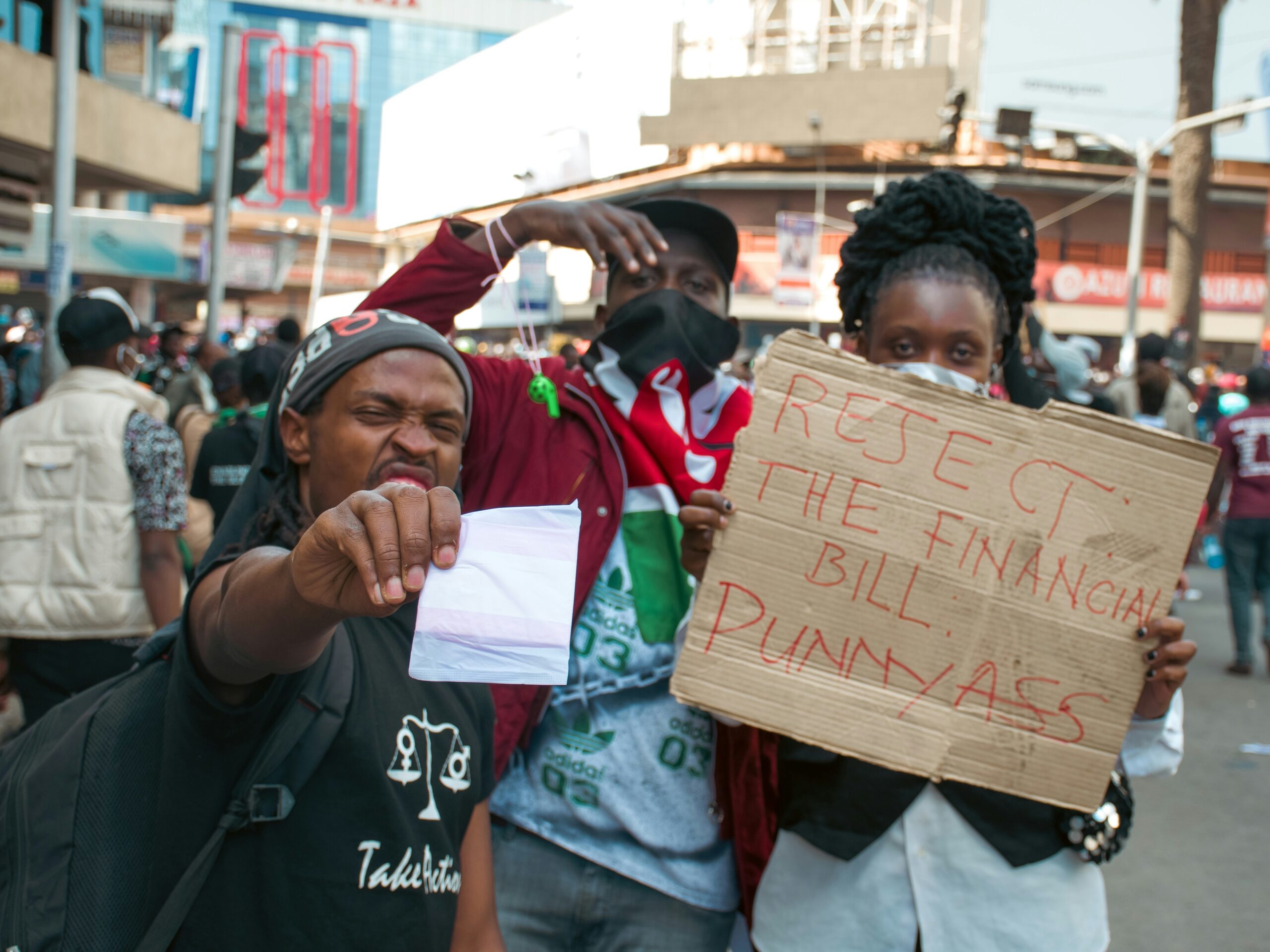Introduction to the Protests
The recent anti-government protests in Kenya have captured global attention, highlighting a volatile political climate and widespread public discontent. The unrest can be traced back to a series of events that began in early 2023, when growing dissatisfaction with the government’s policies and alleged corruption reached a boiling point. The protesters, comprising various factions of the Kenyan society, have been vocal about their demands, which include calls for greater transparency, economic reforms, and an end to police brutality. These grievances have been further exacerbated by rising living costs and high unemployment rates, fueling the intensity and persistence of the demonstrations.
Key demands of the protesters center on the need for fair governance and accountability. They have accused the government of neglecting the needs of the common citizenry while engaging in corrupt practices. The calls for justice have been amplified by reports of human rights abuses, which have become a pivotal rallying point for the protestors. The demonstrators have also expressed their frustration over the lack of economic opportunities and the government’s failure to address the high cost of living, which has put immense pressure on the majority of Kenyans struggling to make ends meet.
In documenting these events, Human Rights Watch (HRW) has played a critical role. The organization has meticulously recorded instances of violence and abuse, providing a comprehensive account of the protests and the government’s response. HRW’s reports have shed light on the excessive use of force by security personnel, which has resulted in significant casualties. Their documentation has not only brought international attention to the crisis but has also underscored the urgent need for intervention and dialogue to address the underlying issues fueling the unrest.
Casualties and Injuries
In the wake of the recent anti-government protests in Kenya, the Human Rights Watch (HRW) has documented a significant number of casualties and injuries. According to the HRW report, at least 30 individuals have lost their lives as a direct result of the confrontations between protesters and security forces. This figure underscores the severity of the situation and the high human cost associated with the unrest.
The nature of injuries sustained during these protests has varied widely. Many of the injured have suffered from gunshot wounds, often inflicted by law enforcement officers attempting to disperse the crowds. Additionally, instances of blunt force trauma have been reported, primarily resulting from the use of batons and other riot control equipment. Tear gas exposure has also led to numerous cases of respiratory issues among protesters, further compounding the health crisis.
Among the notable incidents, the HRW report highlights a particularly violent clash in Nairobi, where security forces allegedly fired live ammunition into a crowd of demonstrators. This incident alone accounted for several deaths and numerous injuries, drawing widespread condemnation from both local and international human rights organizations.
Patterns of violence have emerged from the documented incidents, indicating a troubling trend of excessive use of force by law enforcement. Reports suggest that in many cases, security personnel have resorted to aggressive measures even when faced with peaceful demonstrators. This has raised serious concerns regarding the adherence to principles of proportionality and the protection of human rights during such operations.
The HRW has called for an immediate investigation into these incidents, urging the Kenyan government to hold accountable those responsible for the disproportionate use of force. The organization emphasizes the need for reforms in crowd control tactics to prevent further loss of life and ensure the safety of all individuals exercising their right to protest.
Government Response
The Kenyan government’s response to the recent anti-government protests has been multifaceted, encompassing both verbal statements and concrete measures aimed at restoring order. Key officials have publicly addressed the unrest, emphasizing the need for stability and condemning acts of violence. In a national broadcast, President Uhuru Kenyatta urged for calm and dialogue, while Interior Cabinet Secretary Dr. Fred Matiang’i underscored the government’s commitment to maintaining law and order.
In an effort to curtail the escalating turmoil, the government has implemented several stringent measures. Curfews have been imposed in hotspot regions, restricting movement during specific hours to prevent further clashes and looting. These curfews are enforced rigorously, with police and military personnel patrolling the streets to ensure compliance. Additionally, states of emergency have been declared in particularly volatile areas, granting security forces expanded powers to detain individuals and disperse gatherings.
The methods employed by security forces to control the protests have been a subject of intense scrutiny and debate. Law enforcement agencies have utilized a variety of crowd control tactics, including tear gas, water cannons, and rubber bullets. The use of force has prompted criticism from human rights organizations, which argue that such measures have at times been excessive and indiscriminate. Human Rights Watch (HRW) has documented instances where security personnel allegedly used live ammunition, leading to fatalities and serious injuries among protestors.
Despite the government’s efforts to justify these measures as necessary for preserving public order, the heavy-handed approach has fueled further dissent and international concern. The balance between maintaining security and respecting civil liberties remains a contentious issue, highlighting the complexities faced by authorities in managing large-scale civil unrest. As the situation unfolds, the effectiveness and ethical implications of the Kenyan government’s response will continue to be scrutinized both domestically and abroad.
Human Rights Violations
During the recent anti-government protests in Kenya, the Human Rights Watch (HRW) has documented numerous human rights violations. Among the most alarming reports are unlawful killings, excessive use of force, and arbitrary arrests. These actions have not only intensified the public’s outrage but have also drawn international condemnation.
One of the most egregious examples of human rights violations is the reported use of lethal force by security forces. Witnesses have recounted instances where peaceful protesters were shot at with live ammunition. For example, in Nairobi, a 22-year-old man named John Mwangi was fatally wounded by a stray bullet while merely observing the protest from a distance. His death is a stark reminder of the indiscriminate use of force by authorities.
HRW has also highlighted cases of excessive use of force, which include beatings and the use of tear gas against demonstrators. In Kisumu, multiple protesters reported being physically assaulted by police officers. A 28-year-old woman, Grace Otieno, described how she was beaten with batons and dragged on the ground simply for participating in the protest. Such actions not only violate the right to peaceful assembly but also threaten the physical and psychological well-being of individuals.
Arbitrary arrests have been another significant concern. According to HRW, numerous individuals have been detained without charge, often in overcrowded and unsanitary conditions. In Mombasa, a human rights activist named Peter Karanja was arrested and held for three days without any formal charges. His experience underscores the broader pattern of unlawful detentions aimed at stifling dissent.
These documented abuses paint a grim picture of the current state of human rights in Kenya. The testimonies of victims and witnesses reveal a troubling trend of government overreach and a blatant disregard for fundamental freedoms. It is imperative that these violations are addressed and that those responsible are held accountable to restore trust and ensure justice for the affected individuals.
International Reaction
The international community has expressed significant concern regarding the anti-government protests in Kenya and the associated human rights violations reported by Human Rights Watch (HRW). Several foreign governments have issued statements condemning the violence and urging the Kenyan authorities to exercise restraint. The United States Department of State, for instance, has called for a thorough and transparent investigation into the incidents, emphasizing the importance of upholding democratic principles and human rights.
Similarly, the European Union has voiced its apprehension through a formal declaration, urging the Kenyan government to engage in constructive dialogue with opposition groups to address the underlying issues. The EU has also stressed the need for accountability and the protection of civilians during such unrest. Furthermore, the United Kingdom’s Foreign, Commonwealth & Development Office has highlighted the necessity for immediate measures to de-escalate tensions and prevent further loss of life.
International organizations have also been vocal about the situation. The United Nations, through its Office of the High Commissioner for Human Rights, has called for an impartial investigation and the implementation of measures to safeguard the rights of protestors. Amnesty International has echoed these sentiments, urging the Kenyan authorities to respect the right to peaceful assembly and to refrain from excessive use of force.
Non-governmental organizations (NGOs) have played a crucial role in drawing global attention to the crisis. Human Rights Watch’s detailed report has been pivotal in mobilizing international pressure on the Kenyan government. Other NGOs, such as the International Federation for Human Rights (FIDH), have called for targeted sanctions against individuals responsible for the human rights abuses, advocating for international intervention to ensure justice and accountability.
Collectively, these reactions underscore the broad-based concern over the events in Kenya. The calls for investigations and potential sanctions reflect the global community’s commitment to upholding human rights and maintaining international norms in addressing such crises.
Impact on Kenyan Society
The recent anti-government protests in Kenya, as reported by Human Rights Watch, have had profound repercussions on various facets of Kenyan society. Economically, the demonstrations have led to significant disruptions in both urban and rural areas. Businesses, especially small and medium-sized enterprises, have been adversely affected due to the intermittent closures and reduced consumer footfall. The hospitality and retail sectors, which rely heavily on consistent customer engagement, have experienced sharp declines in revenue, contributing to an overall slowdown in economic activity.
Daily life for Kenyan citizens has been markedly disrupted. The protests have caused frequent road blockades, making it challenging for individuals to commute to work or access essential services. In some regions, schools have been temporarily closed, interrupting the education of countless students. Public transportation services have been erratic, further complicating the routine lives of many Kenyans who depend on these services for their daily commute.
Psychologically, the unrest has instilled a sense of fear and uncertainty among the populace. The violent nature of some protests and the heavy-handed response by security forces have heightened anxieties, particularly among vulnerable groups such as women, children, and the elderly. The constant threat of violence has led to increased stress levels, affecting mental health across communities. Additionally, the societal divisions have deepened as a result of the unrest. Ethnic and political tensions, which have long been a feature of Kenyan society, have been exacerbated, leading to a more polarized environment.
Overall, the anti-government protests have left an indelible mark on Kenyan society, disrupting the economic, social, and psychological fabric of the nation. The need for a peaceful resolution and dialogue is more urgent than ever to restore normalcy and foster unity among the diverse communities in Kenya.
Historical Context
Kenya’s political landscape has been marked by episodes of unrest and protests, often rooted in grievances related to governance, economic inequality, and electoral disputes. The current anti-government protests can be seen as part of a broader historical pattern where citizens have mobilized to express dissatisfaction with the ruling authorities.
One significant period of political unrest occurred in the aftermath of the 2007-2008 presidential election. The disputed election results led to widespread violence, resulting in over 1,100 deaths and the displacement of thousands. This period highlighted deep-seated ethnic tensions and dissatisfaction with the electoral process, issues that have persisted in the Kenyan political arena.
Another notable instance of political unrest took place during the 1990s, when Kenya experienced a wave of pro-democracy protests. These protests were driven by demands for multi-party democracy, as the country had been under single-party rule since independence. The pressure from these demonstrations eventually led to constitutional reforms and the introduction of a multi-party system in 1992.
Comparing the current protests to these past events, several patterns emerge. Economic inequality and perceptions of electoral injustice continue to be major catalysts for unrest. However, there are also significant differences. The current protests are marked by a more organized and widespread mobilization, facilitated by social media and other modern communication tools. Additionally, the scale of violence and the number of casualties reported by Human Rights Watch in the recent protests indicate a heightened level of tension and state response.
Historical grievances, particularly those related to economic disparities and governance, have undoubtedly contributed to the current situation. The ongoing discontent reflects a deeper, unresolved struggle for a more equitable and transparent political system in Kenya. Understanding the historical context is crucial to comprehending the underlying causes of the protests and the potential pathways to resolving the conflict.
Future Outlook
The recent anti-government protests in Kenya, which have resulted in at least 30 fatalities according to the Human Rights Watch (HRW) report, are poised to have significant and far-reaching consequences for the nation. Politically, the unrest highlights deep-seated frustrations and disillusionment among various segments of the population. This discontent could lead to a more polarized political landscape, with increased pressure on the government to implement reforms. In the absence of tangible changes, the potential for recurring protests remains high, posing a challenge to political stability.
From a social perspective, the protests underscore the urgent need for addressing systemic issues such as inequality, corruption, and lack of access to basic services. The government’s response to the HRW report and the protests will be critical in shaping public perception and social cohesion. Effective communication, along with transparent and inclusive policy-making, could help in rebuilding trust between the government and the citizens.
Economically, the unrest could deter both domestic and foreign investments, further exacerbating the country’s economic challenges. The disruption caused by protests can negatively impact key sectors such as tourism, agriculture, and commerce. To mitigate these effects, it is imperative for the government to focus on economic reforms that promote growth, job creation, and equitable distribution of resources.
To address the underlying issues and prevent further unrest, a multifaceted approach is necessary. This includes initiating dialogues with opposition groups, civil society organizations, and community leaders to understand and address grievances. Comprehensive reforms aimed at enhancing governance, accountability, and social equity are essential. Additionally, strengthening institutions that safeguard human rights and ensuring justice for victims of violence will be crucial in fostering a sense of security and fairness.
In conclusion, the future outlook for Kenya hinges on the government’s ability to respond effectively to the current crisis. By addressing the root causes of the unrest through meaningful reforms and fostering an inclusive dialogue, Kenya can navigate this challenging period and build a more stable and prosperous future for all its citizens.



